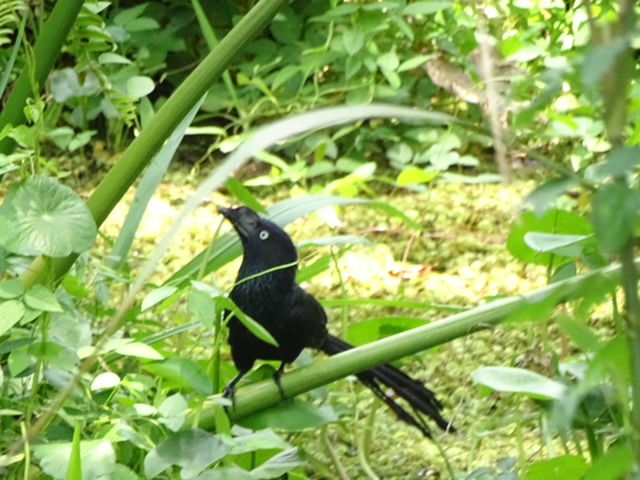After the tram and tower, we went onto the sloth sanctuary.
This morning, we grabbed our binoculars and walked down past the American heritage houses and down the road to the canal.
 |
| Smooth-billed Ani |
Another shot-
Adios, Hansi Fri, Mar 31 at 4:30 PM
 |
| Smooth-billed Ani |
Hello again,
We got up at around four on Saturday to be ready to meet our tour guide by 6:15 a.m. because “traffic would be bad” he said.
We knew we were going on a boat to the canal and supposed we would see the visitor centre and observation tower. We really didn’t have a definite idea what this tour entailed even after trying to worm it out of the tour organizer two different times. We were leaving very early, but we were assured that breakfast and lunch would be included.
Our driver was a young guy who played 80s music through his speakers by choosing various tunes on his cell phone while driving. He also used that phone to check our route from time to time – deviating to another road when there was a blockage.
At one point he was even videoing the road ahead as we drove, and from my vantage point on the backseat, I even saw him take a selfie. His looking down at his phone and up at the road, down at his phone, and up again as he did, in heavy traffic, made me extraordinarily edgy, as you can imagine. Add to that the fact that there were no seatbelts in the backseat.
After a good 45 minutes of driving on four-lane highways that kept merging into other four-lane highways, we circumvented Panama City proper, and wound up at a marina on the Pacific Ocean. It was then that we realized we were going to be getting onto a large boat with others from other tour companies for an excursion through the Canal itself and the 3 locks!
Once all of our fellow cruisers had arrived, we were able to get aboard OUR vessel (open-air on top and an air-conditioned, enclosed lower deck) and head to the western-most end of the Panama Canal past Panama City.
 |
| Panama City skyline in background |
Overhead was a swirl of Brown Pelicans, Frigate Birds, Terns and Black Vultures.
By the way, hardly had we got underway before coffee and little sandwiches appeared - so there actually WAS a breakfast after all.
There was a group of 18 students along - (ranging in age from 14 to 17) the best Young Writers pulled from private and publics schools throughout Central America as ambassadors of their countries and Central America as a whole. Called Semana Cronica #500 Historias -- if you want more info.
Below, we are approaching The Bridge of the Americas that spans the Pacific entrance to the Panama Canal and connects the North and South American land masses.
I have watched many a ship go through the locks on the Welland Canal. It’s amazing. But I had never actually been on a ship while it happened.
We steered into the lock (with another tour boat about our size), the doors closed behind us and we began to lift to a height of 27 feet.
 |
| Now we’re in the lock and the gates are closing. |
This happened at each of the two Miraflores locks up to Miraflores Lake and the last, Pedro Miguel Lock up to the Culebra Cut which took us back to Gamboa. In all, we rose 81 feet.
We passed many a container ship being loaded or unloaded. These giant ships can hold 12,000 to 15,000 containers.
After the last Lock, a delicious hot lunch of chicken, salad and rice was served.
What a Great Day.
Hansi April 2, 8:14 pm
 |
| Internet photo |
Just down the road from us, past the Leaf-cutter Ant tree, is the beginning of a trail called Sendero La Laguna. We decided to walk in and spy stuff with our little eye.
I’m back,
Editor's note: Since I am using Blogspot as more of a web page than a blog, I've had to arrange the posts from last to first so th...
